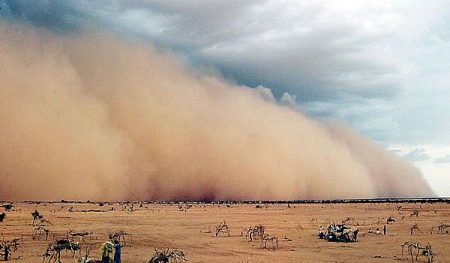October 15, 2018 – In a soon to be published study which will appear in the American Geophysical Union, researchers from New York University in the United Arab Emirates and the Center for Atmosphere Ocean Science, University of Toulouse, and University of Georgia describes how dust aerosols are being transported from the Sahara Desert to the Arctic because of changes in the behaviour of the Jet Stream.
Scientists have noted in several peer-reviewed studies that the Jet Stream in the northern hemisphere is not acting in a normal way. That’s why the last few years have witnessed sudden polar vortices that descend over parts of North America, Europe, and Central Asia, bringing abnormally cold weather for longer than normal periods of time.
It is a meandering Jet Stream that is seen as the cause. And now it is bringing Sahara Desert dust to the North Pole by pulling dust from North African cyclonic events and transporting the stuff in large amounts to the extreme north. The researchers note an increasing frequency in the phenomenon over the last few decades believing that change brought about by rising global temperatures is the primary cause.
The dust forms an aerosol that serves to dampen the normal radiative effect of Arctic ice. The Arctic is seeing more clouds as a result, which rain down grit in the form of carbon and mineral dust which is then deposited on the sea and land ice contributing to accelerated melt. The study states that “coarse size aerosol particles such as dust act like greenhouse gases by absorbing and emitting longwave radiation…..The longwave radiation plays a particularly important role in the energy balance in the Arctic because of prolonged polar nights with little or no sunlight.” The end result, radiative heating of ice surfaces with near-surface temperatures increasing.
The average lifetime of an aerosol particle from the Sahara can vary from days to weeks. Maximum concentrations occur during a period known as the Arctic haze season (late winter and early spring). The aerosols then accumulate as they rain out or fall to the surface where their physical, chemical and thermodynamic properties destabilize the ice surfaces.
The research shows that 60% of the Arctic dust appearing in the spring comes from the Sahara with a lesser contribution from the Taklamakan, Gobi, and other deserts. The mineral and carbon dust contributes to 24% of the absorption mass in the spring and summer contributing to thermodynamic changes in the ice.
This appears to be the first comprehensive study linking Saharan mineral and carbon dust to the Arctic albedo effect responsible for the shrinking of inland glaciers, ice shelves, and sea ice.
The authors of the study used observations from instrumentation on board the Meteosat geostationary satellite to compile the data, as well as data from the European Centre for Medium-range Weather Forecasts. From these sources, they were able to create a computer model that validated the distribution of Saharan dust from North Africa to the Arctic.
Our increasing understanding of the role the Jet Stream plays is significant as data we collect show an increased meandering “in a waveform pattern that allows the extensions of low pressure lobes and cold fronts much further to the south. …. These low pressure lobes can become stationary for a few days and block the normal circulation of the atmosphere.” It is this phenomenon that generates the dust storms in the Sahara and facilitates the transfer of aerosols to the far north.
We now know that here on Earth atmospheric dust can travel a very long way from its source. The phenomenon is not unique to our planet. In the past year, Mars has seen what started as a local dust storm grow into a global one that is only now, many months later, beginning to subside. The rover, Opportunity, may have been a victim of the aerosol storm that blanketed Mars. And recently images and data from the Cassini spacecraft show that a similar phenomenon is native to the Saturnian moon Titan.
While less dramatic than Mars or Titan here on Earth, and less obviously visible, we are witnessing a similar phenomenon on our planet and the movement of the dust poleward and westward is impacting the thermodynamics and albedo of the ice of Greenland, the Canadian Arctic archipelago, and the Arctic Ocean.









